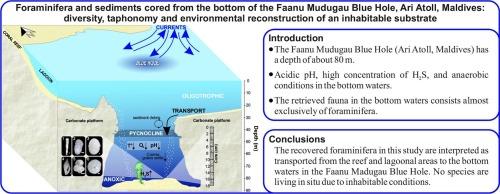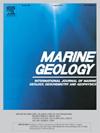Foraminifera and sediments cored from the bottom of the Faanu Mudugau Blue Hole, Ari Atoll, Maldives: Diversity, taphonomy and environmental reconstruction of an inhabitable substrate
IF 2.6
3区 地球科学
Q2 GEOSCIENCES, MULTIDISCIPLINARY
引用次数: 0
Abstract
The Maldives Archipelago is located above the largest carbonate platforms on Earth in the Indian Ocean. The Faanu Mudugau Blue Hole, located in the Ari Atoll (Maldives), is the only one so far discovered in the Indian Ocean and has several peculiarities.
We provide for the first time a comprehensive study of the benthic foraminiferal assemblages recovered from a push core collected from the deepest part of the blue hole; a detailed taxonomy allowed the reconstruction of both abundance and diversity of foraminifera through the recovered core. Despite the acidic bottom conditions and an increase in hydrogen sulfide concentration, the benthic foraminifera of the Faanu Mudugau Blue Hole are well preserved and mostly unaltered. The systematic study gives evidence that benthic foraminifera, retrieved at the bottom of the blue hole at ∼80 m depth, are instead typical of the lagoon in a coral reef environment. The most abundant taxon is the genus Amphistegina, a symbiont-bearing larger benthic foraminifer that commonly lives on macroalgae on well-irradiated seafloors. The predominance of hyaline taxa based on the triplot and the evaluation of the Foram Index, which indicate a good oxygenation condition in the bottom waters, suggest that benthic foraminifera of the Faanu Mudugau Blue Hole have all been transported.
Sediment granulometry, the taphonomic characteristics of foraminiferal shells, and the physical-chemical parameters of the water column confirm the hypothesis that all retrieved benthic foraminifera are transported within the blue hole from the nearby coral reef lagoon, and neither any of the individuals nor any of the taxa identified are living on the blue hole seafloor, making this environment inhospitable for protists. Transport is primarily triggered by sea surface currents, mostly related to seasonal monsoons and tides, which are typical of the Maldivian Archipelago.

马尔代夫阿里环礁 Faanu Mudugau 蓝洞底部的有孔虫和沉积物:可居住基底的多样性、岩石学和环境重建
马尔代夫群岛位于印度洋地球上最大的碳酸盐平台之上。我们首次全面研究了从蓝洞最深处采集的推移岩芯中回收的底栖有孔虫集合体;详细的分类方法使我们能够通过回收的岩芯重建有孔虫的丰度和多样性。尽管海底条件呈酸性,硫化氢浓度增加,但 Faanu Mudugau 蓝洞的底栖有孔虫保存完好,大部分没有发生变化。系统研究证明,在水深 ∼ 80 米的蓝洞底部发现的底栖有孔虫是典型的珊瑚礁泻湖环境。最丰富的类群是 Amphistegina 属,这是一种共生的大型底栖有孔虫,通常生活在辐射良好的海床上的大型藻类上。根据三联图和福拉姆指数的评估,透明类群占主导地位,这表明底层水的含氧量状况良好,这表明法努穆杜高蓝洞的底栖有孔虫都已被运走。沉积物颗粒测定法、有孔虫外壳的移生学特征以及水柱的物理化学参数证实了这一假设,即所有回收的底栖有孔虫都是从附近的珊瑚礁环礁湖中运入蓝洞的,没有任何个体或任何已鉴定的类群生活在蓝洞海底,因此这种环境对原生生物来说是不适宜的。迁移主要是由海面洋流引发的,主要与马尔代夫群岛典型的季节性季风和潮汐有关。
本文章由计算机程序翻译,如有差异,请以英文原文为准。
求助全文
约1分钟内获得全文
求助全文
来源期刊

Marine Geology
地学-地球科学综合
CiteScore
6.10
自引率
6.90%
发文量
175
审稿时长
21.9 weeks
期刊介绍:
Marine Geology is the premier international journal on marine geological processes in the broadest sense. We seek papers that are comprehensive, interdisciplinary and synthetic that will be lasting contributions to the field. Although most papers are based on regional studies, they must demonstrate new findings of international significance. We accept papers on subjects as diverse as seafloor hydrothermal systems, beach dynamics, early diagenesis, microbiological studies in sediments, palaeoclimate studies and geophysical studies of the seabed. We encourage papers that address emerging new fields, for example the influence of anthropogenic processes on coastal/marine geology and coastal/marine geoarchaeology. We insist that the papers are concerned with the marine realm and that they deal with geology: with rocks, sediments, and physical and chemical processes affecting them. Papers should address scientific hypotheses: highly descriptive data compilations or papers that deal only with marine management and risk assessment should be submitted to other journals. Papers on laboratory or modelling studies must demonstrate direct relevance to marine processes or deposits. The primary criteria for acceptance of papers is that the science is of high quality, novel, significant, and of broad international interest.
 求助内容:
求助内容: 应助结果提醒方式:
应助结果提醒方式:


